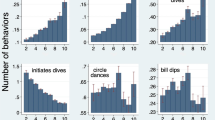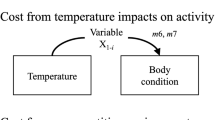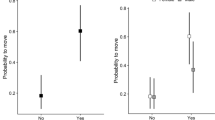Summary
We used sequential removal experiments to test whether the resource-holding potential (RHP) of territory “owner” red-winged blackbirds, Agelaius phoeniceus, was superior to that of their first replacements (“shallow floaters”) and subsequent replacements (“deep floaters”). Among the removals were secondyear males, which were morphologically inferior to adults and which also tended to be competitively inferior in aviary contests. The highest proportion of secondyear males occurred in the deep floater class. Thus, the RHP of some deep floaters was inferior to that of owners and shallow floaters. However, among adults, owners, shallow floaters, and deep floaters had equivalent morphological and competitive RHP. Furthermore, replacement males that had defended territories for many days were neither morphologically nor competitively superior to males that had defended territories for only a few days. Our results suggest that RHP distinguishes adults from second-year males, but does not separate owners from floaters. The only hypothesis that is potentially supported by our observations is that owners have a greater expected payoff from their territory than intruders, and in this way owners are able to maintain site dominance. The nature of that payoff remains to be determined.
Similar content being viewed by others
References
Beletsky LD, Orians GH (1987) Territoriality among male redwinged blackbirds II. Removal experiments and site dominance. Behav Ecol Sociobiol 20:339–349
Beletsky LD, Orians GH (1989) Territoriality among male redwinged blackbirds III. Testing hypotheses of territorial dominance. Behav Ecol Sociobiol 24:333–339
Darwin C (1871) The descent of man and selection in relation to sex. The Modern Library, New York
Davies NB (1978) Territorial defence in the speckled wood butterfly (Pararge aegeria): the resident always wins. Anim Behav 26:138–147
Desrochers A, Hannon SJ (1989) Site-related dominance and spacing among winter flocks of black-capped chickadees. Condor 91:317–323
Eckert CG, Weatherhead PJ (1987a) Owners, floaters and competitive asymmetries among territorial red-winged blackbirds. Anim Behav 35:1317–1323
Eckert CG, Weatherhead PJ (1987b) Ideal dominance distributions: a test using red-winged blackbirds (Agelaius phoeniceus). Behav Ecol Sociobiol 20:43–52
Eckert CG, Weatherhead PJ (1987c) Competition for territories in red-winged blackbirds: is resource-holding potential realized? Behav Ecol Sociobiol 20:369–375
Enquist M, Leimar O (1990) The evolution of fatal fighting. Anim Behav 39:1–9
Fiala KL (1981) Sex ratio constancy in red-winged blackbirds. Evolution 35:898–910
Freeman S, Jackson WM (1990) Univariate metrics are not adequate to measure avian body size. Auk 107:69–74
Getty T (1981) Competitive collusion: the preemption of competition during the sequential establishment of territories. Am Nat 118:426–431
Getty T (1987) Dear enemies and the prisoner's dilemma: why territorial neighbors form defensive coalitions. Am Zool 27:327–336
Godfrey WE (1986) The birds of Canada, revised edition. National Museum of Natural Sciences, National Museums of Canada
Grafen A (1987) The logic of divisively asymmetric contests: respect for ownership and the desperado effect. Anim Behav 35:462–467
Hogstad O (1989) The presence of non-territorial males in willow warbler Phylloscopus trochilus populations — a removal study. Ibis 131:263–267
Krebs JR (1982) Territorial defence in the great tit (Parus major): do residents always win? Behav Ecol Sociobiol 11:185–194
Laux LJ Jr (1970) Non-breeding surplus and population structure of the red-winged blackbirds (Agelaius phoeniceus). PhD dissertation, University of Michigan
Maynard Smith J, Parker GA (1976) The logic of asymmetric contests. Anim Behav 24:159–175
Monnett C, Rotterman LM, Worlein C, Halupka K (1984) Copulation patterns of red-winged blackbirds (Agelaius phoeniceus). Am Nat 124:757–764
Nie NH (1988) SPSS Statistical package for the social sciences. McGraw-Hill, New York
Orians GH, Christman GM (1968) A comparative study of the behavior of the red-winged, tricolored and yellow-headed blackbirds. Univ Calif Publ Zool 84:1–85
Parker GA (1974) Assessment strategy and the evolution of fighting behaviour. J Theor Biol 47:223–243
Peek FW (1971) Seasonal change in the breeding behavior of the male red-winged blackbird. Wilson Bull 83:383–395
Peek FW (1972) An experimental study of the territorial function of vocal and visual display in the male red-winged blackbird (Agelaius phoeniceus). Anim Behav 20:112–118
Piper WH, Wiley RH (1989) Correlates of dominance in wintering white-throated sparrows: age, sex, and location. Anim Behav 37:298–310
Reid M (1987) Costliness and reliability in the singing vigour of Ipswich sparrows. Anim Behav 35:1735–1743
Rohwer S (1982) The evolution of reliable and unreliable badges of fighting ability. Am Zool 22:531–546
Rohwer S, Fretwell SD, Niles DM (1980) Delayed plumage maturation and the deceptive acquisition of resources. Am Nat 115:404–437
Roskaft E, Rohwer S (1987) An experimental study of the function of red epaulettes and the black body colour of male red-winged blackbirds. Anim Behav 35:1070–1077
Rothstein SI, Yokel DA, Fleischer RC (1986) Social dominance, mating and spacing systems, female fecundity, and vocal dialects in captive and free-ranging brown-headed cowbirds. Curr Ornithol 3:127–185
Rowell TE (1974) The concept of social dominance. Behav Biol 11:131–154
Santee WR, Bakken GS (1987) Social displays in red-winged blackbirds (Agelaius phoeniceus): sensitivity to thermoregulatory costs. Auk 104:413–320
Searcy WA (1979a) Sexual selection and body size in red-winged blackbirds. Evolution 33:649–661
Searcy WA (1979b) Morphological correlates of dominance in captive male red-winged blackbirds. Condor 81:417–420
Searcy WA (1979c) Male characteristics and prairing success in red-winged blackbirds. Auk 96:353–363
Searcy WA, Yasukawa K (1981) Sexual size dimorphism and survival of male and female blackbirds (Icteridae). Auk 98:458–465
Smith DG (1976) An experimental analysis of the function of redwinged blackbird song. Behaviour 61:136–155
Smith JNM, Arcese P (1989) How fit are floaters? Consequences of alternate territorial behaviors in a non-migratory sparrow. Am Nat 133:830–845
Stamps JA (1987) The effect of familiarity with a neighborhood on territory acquisition. Behav Ecol Sociobiol 21:273–277
Tatner P, Bryant DM (1986) Flight cost of a small passerine measured using doubly-labelled water: implications for energetics studies. Auk 103:169–180
Weatherhead PJ (1983) Secondary sex ratio adjustment in redwinged blackbirds (Agelaius phoeniceus). Behav Ecol Sociobiol 12:57–61
Author information
Authors and Affiliations
Additional information
Offprint requests to: P.J. Weatherhead
Rights and permissions
About this article
Cite this article
Shutler, D., Weatherhead, P.J. Owner and floater red-winged blackbirds: determinants of status. Behav Ecol Sociobiol 28, 235–241 (1991). https://doi.org/10.1007/BF00175095
Received:
Accepted:
Issue Date:
DOI: https://doi.org/10.1007/BF00175095




